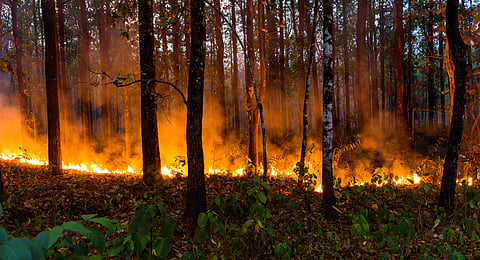

Tree cover loss from fires surged 370% in tropical primary forests in 2024
3.1 gigatonnes of CO₂ released—8% of total global emissions
Record wildfires in the US, Canada, EU and Asia underline climate–fire feedback
Despite drop in Amazon deforestation, drought-driven fires continue
Wildlife populations have plunged 73% in five decades
Global tree cover loss due to fires reached an all-time high in 2024, with tropical primary forests burning 370 per cent more area than in 2023 — releasing massive carbon emissions and driving biodiversity loss.
According to The 2025 state of the climate report: A planet on the brink published on October 30, 2025, the total global tree cover loss was estimated at 29.6 million hectares (Mha) in 2024 — the second highest on record and 4.7 per cent higher than in 2023. The sharp increase was largely attributed to a surge in fire-related losses, exacerbated by climate change and El Niño conditions.
“The losses within tropical primary forest were particularly large in 2024, with fire-related losses reaching a record high of 3.2 Mha, compared with just 0.69 Mha in 2023—a 370 per cent increase,” the report stated.
The fires also caused severe biodiversity and ecosystem losses, with the destruction of tropical primary forests in 2024 alone emitting nearly 3.1 gigatonnes of carbon dioxide (CO₂) equivalent — around 8 per cent of all human-induced emissions that year.
The crisis has continued into 2025, with massive wildfires recorded across continents. In January, blazes in California, United States scorched over 57,000 acres, leaving behind an estimated $250 billion in economic damages. In March, wildfires ravaged 370 hectares in Japan and 48,000 hectares in South Korea.
By May, Canada witnessed one of its most intense early-season fire outbreaks on record, burning 1.58 million hectares, largely driven by climate change. By August, the European Union’s wildfire season had already become its most extensive ever, exceeding 1 million hectares of burned land.
“This exemplifies a dangerous climate feedback loop,” the report warned, “as fires release vast carbon emissions that accelerate global warming, which in turn fuels more fire activity.”
Wildfires also have immediate public health consequences, with smoke exposure linked to increased morbidity and mortality, it added.
In contrast, deforestation in Brazil’s Amazon rainforest fell by nearly 30 per cent in 2024, reaching its lowest rate in nine years. By July 31, 2024, about 0.63 million hectares had been cleared, compared with 0.9 million hectares during the same period in 2023, due to stronger environmental enforcement.
However, despite this progress, the region experienced a significant rise in fires caused by severe drought, the report noted. “These fires, which are not always classified as deforestation, have raised concerns about ongoing ecosystem degradation and the challenges of accurately monitoring forest health.”
The Amazon remains under severe threat from both climate change and human activity, underscoring the need for sustained conservation and resilience-building efforts. By 2050, as much as 47 per cent of the Amazon could face compounding disturbances, potentially leading to irreversible ecosystem transitions, the report warned.
It also highlighted the accelerating global biodiversity crisis, with wildlife populations plummeting by 73 per cent over the past five decades. Climate change has become a dominant driver of biodiversity loss, affecting species across geographies and ranges.
Currently, over 3,500 assessed wild animal species are directly threatened by climate change, with several already showing signs of population collapse. The report cautioned that the broader ecological and economic consequences of these changes remain poorly understood but are likely to intensify.
Climate-related disruptions to biodiversity could have far-reaching impacts on agriculture, food security, recreation, tourism, and even the spread of animal-borne diseases, it said.
Among ecosystems of particular concern are coral reefs — rich in biodiversity and crucial to hundreds of millions of people globally — which are being devastated by ocean warming, overfishing, and pollution.